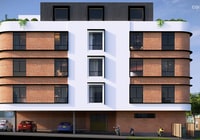
How much office space do I need?
There is no one-size-fits-all method to how much office space per employee is required in a work place.
To predict how much space an organisation requires, you must understand the business and the nature of its operations, according to Colliers International workplace strategy associate director Sven Moller.
“Every client we work with has their own unique requirements and workplace mix, that’s what gives each office its own identity,” he said.
Put simply, office floor space is measured in square metres on a net internal basis, excluding toilets, services ducts, stairways and lifts (assuming shared), and opposing lift-bank lobbies.
Knight Frank NSW office leasing director Tina Raftopoulos suggests a tenant considers the projected growth of their business over a three-to-five-year period to ensure there is sufficient levels of space.
How much office space do I really need?
This depends on many factors and on the nature of the business and how it works.
Some questions to ask when it comes to how much office space per person is needed include:
- Does your business need private offices? Does each employee need one desk per person or is there room for flexible working options?
- Is the floor plan practical? Is the space a regular shape or are there barriers, such as columns? Does the area provide a sufficient working environment, i.e. office or open floor plan?
- Are there other space offerings in the building, such as shared meeting rooms or serviced office spaces that are able to accommodate for growth in staff members?
How much office space do I need per employee?
As a rule of thumb, businesses require roughly between 8 and 12 square metres of gross space per employee, inclusive of communal spaces for a modern open-plan workspace, according to Colliers International.
This figure increases if private offices are required, or if a large amount of meeting room space is needed.
Buildings are becoming denser, with some companies moving from 1:10 staff to square metre ratio to a 1:8 staff to square metre ratio for some parts of their workplace.
“There are two things to consider when thinking about the amount of space in a new workplace: the number of people the office needs to accommodate and the spaces and settings required to support the people,” Mr Moller said.
“So, do people need more quiet, smaller, private areas or open collaborative spaces to accommodate large groups? Does every person require their own desk or can desks be shared amongst multiple people?”
What are the typical office sizes?
According to Knight Frank, working on an office space ratio of 8 to 15 square metres per person is preferable.
| Office type | Dimensions |
| Typical/standard office | 10-12 m² |
| Large office | 12-15 m² |
| Supervisor workstation | 6-10 m² |
| Standard workstation | 4-6 m² |
Source: Knight Frank
A 1.8-metre-wide bench style work stage is the most common desk allocation within each office, Colliers International says.
Bench or linear workstations are the most efficient work point type when planned correctly, and assist in optimising space and zoning.
Remaining space can then be allocated to more collaboration and focus areas to assist employee productivity.
Office sizes can vary between nine to 15 square metres plus but there is a general trend for less private office space and more communal meeting space with smaller private areas.
Some organisations provide dedicated small meeting or quiet rooms for senior leadership in lieu of offices, says Colliers.










